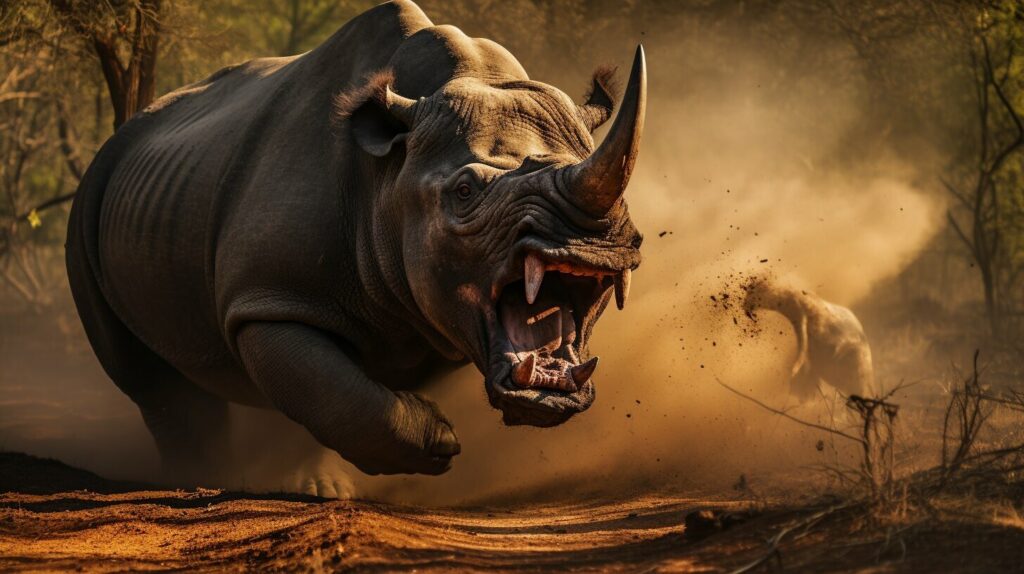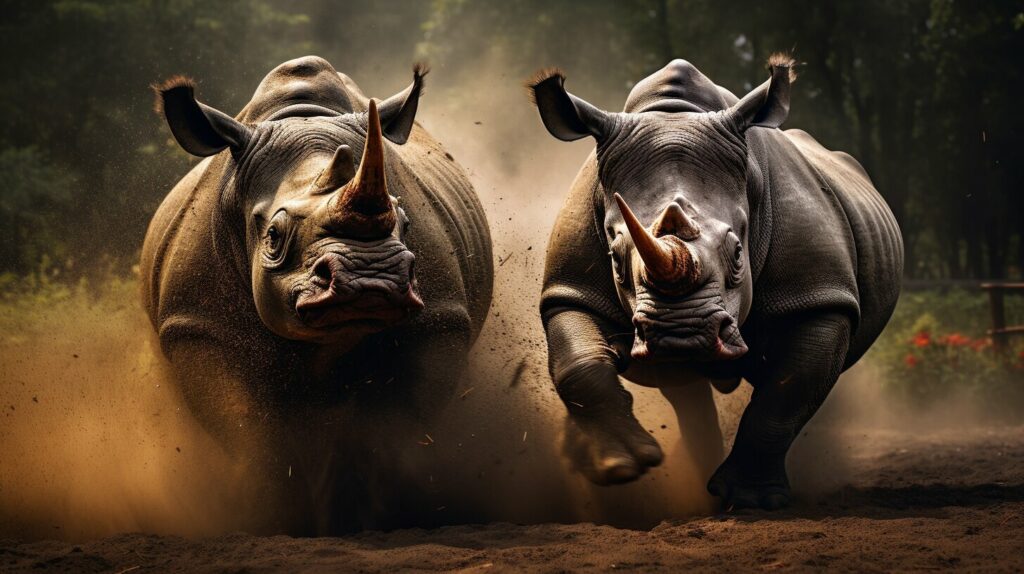In the heart of nature, a fierce battle between two powerful creatures, the Rhino and the Bear, unfolds, captivating wildlife enthusiasts and revealing unexpected results. This epic showdown between these formidable animals has long been a topic of speculation and intrigue. In this article, we will delve into the size, strength, and behavior of Rhinos and Bears, analyzing their chances in a hypothetical battle. Prepare to be amazed as we unveil the surprising outcomes of this epic Rhino vs Bear clash.
- Rhinos and Bears differ in size, strength, and natural habitats.
- Their behavior is shaped by unique instincts and adaptations.
- Analyzing potential battle scenarios can reveal the winner.
- Scientific evidence and real-life encounters provide surprising outcomes.
- Conservation efforts are crucial for preserving their habitats.
Rhino vs Bear Comparison: Size, Strength, and Habitat
When comparing Rhinos and Bears, it becomes apparent that their physical attributes, including size and strength, as well as their habitats, play a crucial role in determining the outcome of their face-off. Let’s delve into these factors to understand how they contribute to the epic Rhino vs. Bear showdown.
Size: Both Rhinos and Bears are formidable creatures in their own right, but their sheer size sets them apart. Rhinos are known for their massive build, with the average adult weighing between 1,500 to 3,000 kilograms. On the other hand, Bears, particularly the grizzly species, can weigh up to 600 kilograms. It’s clear that Rhinos possess a significant advantage in terms of size, enabling them to exert a greater amount of force during a confrontation.
Strength: While Bears are known for their incredible strength, particularly in their forelimbs, Rhinos possess immense power as well. Rhinos are equipped with a muscular hump that enables them to charge at astonishing speeds, reaching up to 30 miles per hour. Their horn, made of keratin, is a formidable weapon that can inflict serious damage. Bears, on the other hand, rely on their powerful jaws and sharp claws to defend themselves. This discrepancy in natural weapons showcases the differing fighting techniques employed by these two majestic creatures.
Habitat: Rhinos and Bears inhabit distinct environments, which also contributes to their individual strengths. Rhinos are primarily found in grasslands and savannahs, while Bears thrive in diverse habitats such as forests, tundras, and mountains. The open plains favor the speed and agility of Rhinos during a confrontation, while the Bears’ adaptability to various terrains gives them an edge in navigating challenging landscapes. Understanding their respective habitats provides crucial insights into how Rhinos and Bears harness their surroundings to their advantage in combat.
| Comparison | Rhinos | Bears |
|---|---|---|
| Size | 1,500 – 3,000 kilograms | Up to 600 kilograms |
| Strength | Powerful charge and horn | Strong jaws and sharp claws |
| Habitat | Grasslands and savannahs | Forests, tundras, and mountains |
As we analyze the Rhino vs. bear battle, it is evident that both size and strength are critical factors in determining their chances of victory. However, the unique adaptations and tactics honed in their respective habitats also come into play. In the next section, we will explore the behavioral characteristics of Rhinos and Bears, delving deeper into their instincts and adaptations, which shed further light on the potential outcome of their epic wilderness showdown.
Rhino vs Bear Behavior: Instincts and Adaptations
Understanding the instinctual behaviors and remarkable adaptations of Rhinos and Bears provides valuable insights into their strategies during the epic wilderness showdown. Both animals have evolved unique characteristics that enable them to thrive in their respective habitats and navigate the challenges of survival.
Rhinos, known for their immense size and strength, possess a docile demeanor in normal circumstances. However, when provoked or threatened, their territorial nature kicks in, and they can become fiercely aggressive. Rhinos have an acute sense of smell and hearing, allowing them to detect potential dangers from a distance. When confronted, they rely on their sharp horns as defensive weapons, using them to charge at their opponents with tremendous force. This powerful charge, combined with their massive size, makes Rhinos a formidable force to reckon with in the wild.
Bears, on the other hand, are known for their adaptability and intelligence. They display a range of behaviors depending on the situation, from peaceful solitude to protective aggression. With their sharp claws and powerful jaws, bears have the ability to defend themselves effectively. While they generally prefer a solitary lifestyle, they can exhibit protective instincts when their cubs are threatened. Bears are also highly skilled at foraging for food, utilizing their keen sense of smell to locate various food sources, including berries, fish, and scavenged carcasses.

As the epic showdown between Rhinos and Bears unfolds, their instinctual behaviors and remarkable adaptations will undoubtedly play a significant role in determining the outcome. Their contrasting characteristics and strategies will clash, creating a mesmerizing display of nature’s raw power. As spectators, we have the privilege to witness this enthralling battle, while also recognizing the importance of preserving their natural habitats and ensuring the coexistence of these magnificent creatures.
Rhino vs Bear Fight: Analyzing the Battle
Dive into the gripping intensity of the Rhino vs. bear fight, exploring the decisive factors that could tip the scales in favor of one mighty creature over the other. When pitting these formidable beasts against each other, several key aspects demand consideration. The Rhino, with its massive size and robust build, possesses raw power and an intimidating presence. On the other hand, the Bear, renowned for its strength and agility, presents a formidable opponent in its own right. Both animals are known for their territorial nature, making this battle a clash of titans in the animal kingdom.
Size plays a significant role in determining the outcome of such confrontations. The Rhino, with its weight ranging from 2,000 to 6,000 pounds, boasts a distinct advantage in terms of sheer mass. Its thick, horned exterior provides a powerful defense mechanism, capable of inflicting devastating blows on its opponent. Conversely, the Bear, although typically weighing between 200 to 1,500 pounds, compensates for its slightly smaller size with incredible speed and agility. Its sharp claws and powerful jaws give it a lethal advantage in close-quarters combat.
Furthermore, habitat and adaptation also influence the Rhino vs. bear battle. Rhinos are known to thrive in savannah grasslands and dense forests, relying on their armored bodies as an effective defense against predators. Bears, adaptable creatures, can be found in various habitats, from tundras to forests, displaying impressive climbing skills and a diverse diet. These differing habitats and adaptations may impact the strategies employed by the Rhino and Bear during their battle.
As the Rhino vs. bear fight unfolds, instinct and tactics will come into play. While the Rhino relies on its brute force and horned attacks, the Bear employs a combination of strength, agility, and cunning. The outcome of their battle will depend on factors such as the animals’ stamina, experience in combat, and the ability to exploit weaknesses. Whether the Rhino’s charging assault can overpower the Bear’s strategic maneuvers, or if the Bear’s agile strikes can penetrate the Rhino’s formidable defense, remains to be seen.
Ultimately, the Rhino vs. bear fight is a truly unpredictable contest, showcasing the impressive capabilities of both creatures. Respect for these magnificent animals should be the key takeaway from this analysis. They symbolize the untamed wonders of the wilderness, each with its unique strengths and weaknesses. As observers, we must embrace awe and fascination for these incredible battles, while recognizing the importance of preserving their natural habitats and ensuring their survival in the wild.

- Size and strength: The Rhino’s immense size and solid build versus the Bear’s strength and agility.
- Habitat and adaptation: The Rhino’s preference for grasslands and forests versus the Bear’s adaptability across various habitats.
- Instinct and tactics: The Rhino’s charging assault versus the Bear’s combination of strength, agility, and cunning.
| Rhino | Bear |
|---|---|
| Massive size (2,000 – 6,000 pounds) | Impressive strength and agility (200 – 1,500 pounds) |
| Powerful horned defense mechanism | Sharp claws and powerful jaws |
| Thrives in savannah grasslands and dense forests | Adaptable to various habitats, from tundras to forests |
“The Rhino Vs Bear fight is a truly unpredictable contest, showcasing the impressive capabilities of both creatures.”
Rhino vs Bear: Surprising Outcomes Unveiled
Prepare to be astonished as we unveil the captivating results of the Rhino vs. bear battle, shedding light on their extraordinary abilities and unexpected vulnerabilities. In this fierce wilderness showdown, both the rhino and the bear display immense strength and resilience, but the outcome of their encounter reveals intriguing insights into their unique characteristics.
“The battle between these two formidable creatures is not merely a clash of brute force, but a test of instinct, adaptability, and survival.”
Contrary to popular belief, size does not always guarantee victory. While the bear may possess a formidable stature and powerful physique, the rhino’s sheer mass and armored exoskeleton provide it with a formidable defense. The rhino’s horn, a piercing weapon capable of inflicting grave injuries, gives it a distinct advantage during a confrontation. On the other hand, the bear’s agility, sharp claws, and savage biting force make it a formidable opponent. It possesses the ability to climb trees, swim with ease, and deliver swift, devastating attacks.
When analyzing their behavior, it becomes evident that the rhino and the bear have developed unique instincts and adaptations to thrive in their respective environments. Rhinos, with their solitary nature, rely on their keen senses and acute hearing to detect potential threats. Their charging capabilities, reaching speeds of up to 30 miles per hour, are a sight to behold. Bears, on the other hand, exhibit a wide range of behaviors, from the fiercely protective mama bear to the elusive grizzly. Their intelligence, adaptability, and omnivorous diet contribute to their survival in diverse habitats.
The Surprising Outcomes
It is essential to note that every confrontation between a rhino and a bear is unpredictable and entirely circumstantial. While there have been instances of bears overpowering rhinos, and vice versa, the most surprising outcome of their battle is often the mutual respect they develop. More often than not, these majestic creatures avoid confrontation when their paths cross. Their instincts guide them to navigate the wild without unnecessary violence, understanding that survival lies in harmony and coexistence.
As we delve deeper into the realm of this epic wilderness showdown, fascinating details about the rhino and bear reveal themselves. Captivating research studies, real-life encounters, and expert analysis provide us with an intimate understanding of these extraordinary creatures. So, brace yourself to witness the astonishing results of the Rhino vs. Bear battle, a testament to the remarkable wonders of the natural world.
| Rhino | Bear |
|---|---|
| Massive size and armored exoskeleton | Formidable stature and powerful physique |
| Piercing horn for offense | Sharp claws and savage biting force |
| Keen senses and acute hearing | Agility and climbing abilities |
| Charging capabilities at high speeds | Swimming skills and swift attacks |
| Solitary nature | Range of behaviors and adaptability |
Rhino vs. Bear: Implications for Wildlife Conservation
The epic encounter between the Rhino and the Bear serves as a powerful reminder of the urgent need to protect their habitats and safeguard these magnificent creatures for future generations. Rhinos and Bears are majestic creatures, each with unique habitats that are essential for their survival and well-being.
Let’s start by exploring the Rhino’s habitat. These remarkable creatures can be found in various parts of the world, including Africa and Asia. Rhinos are typically found in grasslands, savannas, and dense forests. They rely on these diverse habitats for food, mating, and raising their young. However, due to habitat destruction and poaching, many Rhino species are critically endangered, facing the risk of extinction. It is crucial to conserve and restore their habitats, ensuring they have sufficient space and resources to thrive.
On the other hand, Bears have their own distinct habitats. They can be found in different regions, from the polar regions to temperate forests. Bears are adaptable creatures, able to survive in a range of environments. However, like Rhinos, Bears face numerous threats. Deforestation, climate change, and illegal hunting pose significant risks to their habitats and populations. Conservation efforts must prioritize the protection and restoration of Bear habitats, ensuring these incredible animals can continue to roam freely in their natural environments.
The survival of Rhinos and Bears is intricately linked to the conservation of their respective habitats. By safeguarding these habitats and addressing the factors that threaten them, we can support the long-term survival of these magnificent creatures. It is imperative that we raise awareness, support conservation initiatives, and advocate for the preservation of our planet’s biodiversity. Together, we can make a difference and ensure a future where Rhinos and Bears continue to inspire and captivate us with their extraordinary presence.

Rhino vs Bear: Human Perceptions and Animal Fierceness
Delve into the fascinating realm of human perceptions and attitudes towards animal fierceness, where surveys reveal intriguing insights into how people perceive their chances against formidable creatures like Rhinos and Bears. According to a recent YouGov survey, 6 percent of Americans believe they could fight a grizzly bear unarmed and win. However, most Americans have a more modest assessment of their fighting skills, with the majority saying they would be more confident in a fight against a rat, goose, or house cat.
The survey paired up 34 animals, including humans, to determine which respondents believe is the fiercest. Elephants and rhinos came out on top with 74 percent, followed by grizzly bears and tigers with 73 and 70 percent respectively. The survey also found that 8 percent of respondents think they could beat a gorilla, while 49 percent believe they could triumph in a battle against a medium-sized dog. The survey revealed a gender difference in responses, with 61 percent of men expressing confidence in winning an unarmed fight against a dog compared to only 39 percent of women. However, both men and women showed similar levels of confidence when it came to facing off against an elephant, grizzly bear, or rhino.
Overall, the survey provides insights into American perceptions of animal fierceness and personal fighting abilities. It highlights the differences in confidence levels between various animals and offers a glimpse into the public’s understanding of their own physical prowess. While it is important to respect and appreciate the power of creatures like Rhinos and Bears, it is equally important to recognize our limitations and prioritize their conservation to ensure a harmonious coexistence in the wilderness.

Conclusion: Rhino Vs Bear – Nature’s Unpredictable Drama
As we conclude this exploration of the Rhino Vs Bear battle, we are reminded of the raw power and unpredictability of nature, leaving us in awe of the magnificent creatures that inhabit our planet.
According to a recent YouGov survey, 6 percent of Americans believe they could fight a grizzly bear unarmed and win. However, most Americans have a more modest assessment of their fighting skills, with the majority saying they would be more confident in a fight against a rat, goose, or house cat. The survey paired up 34 animals, including humans, to determine which respondents believe is the fiercest. Elephants and rhinos came out on top with 74 percent, followed by grizzly bears, and tigers with 73 and 70 percent, respectively.
The survey also found that 8 percent of respondents think they could beat a gorilla, while 49 percent believe they could triumph in a battle against a medium-sized dog. The survey revealed a gender difference in responses, with 61 percent of men expressing confidence in winning an unarmed fight against a dog compared to only 39 percent of women. However, both men and women showed similar levels of confidence when it came to facing off against an elephant, grizzly bear, or rhino. Overall, the survey provides insights into American perceptions of animal fierceness and personal fighting abilities.
As we reflect on the Rhino vs. bear battle, it becomes clear that these two powerful creatures possess unique strengths and adaptations that make them formidable opponents in the wild. Their sheer size, strength, and natural weapons make any encounter between them a truly captivating display of nature’s might. It is a humbling reminder that even the most confident of humans would find themselves at a significant disadvantage in such a battle.
Therefore, we must respect and appreciate these awe-inspiring wonders of the natural world. Instead of seeking confrontations and attempting to claim victory over nature’s creations, let us embrace the opportunity to marvel at their grandeur and work towards their conservation. By preserving their respective habitats and ensuring their survival in the wild, we can cherish the ongoing drama between the Rhino and the Bear, a spectacle that serves as a testament to the breathtaking biodiversity of our planet.
FAQ
What is the main focus of this article?
This article explores the epic Rhino vs. bear battle and reveals surprising outcomes.
How does the Rhino’s size compare to that of a Bear?
Rhinos are generally larger than bears, with their size and weight varying depending on the species.
What are the key differences between the Rhino and the Bear?
Rhinos and bears differ in terms of their physical characteristics, natural habitats, and behavioral tendencies.
What are some surprising facts about Rhinos and Bears?
This article unveils surprising facts about both Rhinos and Bears, highlighting their unique strengths and weaknesses.
How does the Rhino vs. Bear battle impact wildlife conservation?
The battle between Rhinos and Bears emphasizes the importance of preserving their natural habitats and ensuring their survival in the wild.
What do surveys reveal about human perceptions of animal fierceness?
Surveys indicate that people have different levels of confidence when facing off against animals like Rhinos and Bears.



